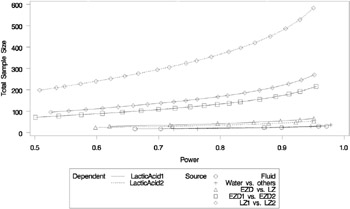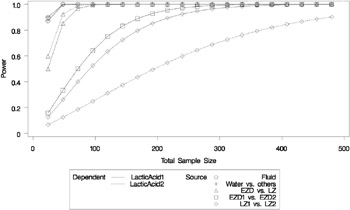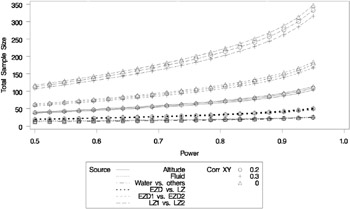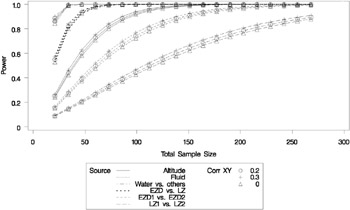Examples
Example 34.1. One-Way ANOVA
This example deals with the same situation as in Example 57.1 on page 3536 of Chapter 57, The POWER Procedure.
Hocking (1985, p. 109) describes a study of the effectiveness of electrolytes in reducing lactic acid buildup for long-distance runners. You are planning a similar study in which you will allocate five different fluids to runners on a 10-mile course and measure lactic acid buildup immediately after the race. The fluids consist of water and two commercial electrolyte drinks, EZDure and LactoZap, each prepared at two concentrations, low (EZD1 and LZ1) and high (EZD2 and LZ2).
You conjecture that the standard deviation of lactic acid measurements given any particular fluid is about 3.75, and that the expected lactic acid values will correspond roughly to Table 34.7. You are least familiar with the LZ1 drink and hence decide to consider a range of reasonable values for that mean.
| Water | EZD1 | EZD2 | LZ1 | LZ2 |
| 35.6 | 33.7 | 30.2 | 29 or 28 | 25.9 |
You are interested in four different comparisons, shown in Table 34.8 with appropriate contrast coefficients.
| Contrast | Coefficients | ||||
|---|---|---|---|---|---|
| Comparison | Water | EZD1 | EZD2 | LZ1 | LZ2 |
| Water versus electrolytes | 4 | ˆ’ 1 | ˆ’ 1 | ˆ’ 1 | ˆ’ 1 |
| EZD versus LZ |
| 1 | 1 | ˆ’ 1 | ˆ’ 1 |
| EZD1 versus EZD2 |
| 1 | ˆ’ 1 |
|
|
| LZ1 versus LZ2 |
|
|
| 1 | ˆ’ 1 |
For each of these contrasts you want to determine the sample size required to achieve a power of 0.9 for detecting an effect with magnitude in accord with Table 34.7. You are not yet attempting to choose a single sample size for the study, but rather checking the range of sample sizes needed for individual contrasts. You plan to test each contrast at ± = 0 . 025. In the interests of reducing costs, you will provide twice as many runners with water as with any of the electrolytes; that is, you will use a sample size weighting scheme of 2:1:1:1:1.
Before calling PROC GLMPOWER, you need to create the exemplary data set to specify means and weights for the design profiles:
data Fluids; input Fluid $ LacticAcid1 LacticAcid2 CellWgt; datalines; Water 35.6 35.6 2 EZD1 33.7 33.7 1 EZD2 30.2 30.2 1 LZ1 29 28 1 LZ2 25.9 25.9 1 ; run;
The variable LacticAcid1 represents the cell means scenario with the larger LZ1 mean (29), and LacticAcid2 represents the scenario with the smaller LZ1 mean (28). The variable CellWgt contains the sample size allocation weights.
Use the DATA= option in the PROC GLMPOWER statement to specify Fluids as the exemplary data set. The following statements perform the sample size analysis:
proc glmpower data=Fluids; class Fluid; model LacticAcid1 LacticAcid2 = Fluid; weight CellWgt; contrast "Water vs. others" Fluid 1 1 1 1 4; contrast "EZD vs. LZ" Fluid 1 1 1 1 0; contrast "EZD1 vs. EZD2" Fluid 1 1 0 0 0; contrast "LZ1 vs. LZ2" Fluid 0 0 1 -1 0; power stddev = 3.75 alpha = 0.025 ntotal = . power = 0.9; run;
The CLASS statement identifies Fluid as a classification variable. The MODEL statement specifies the model and the two cell means scenarios LacticAcid1 and LacticAcid2 . The WEIGHT statement identifies CellWgt as the weight variable. The CONTRAST statement specifies the contrasts. Since PROC GLMPOWER processes class levels in order of formatted values, the contrast coefficients correspond to the following order: EZD1, EZD2, LZ1, LZ2, Water. The POWER statement specifies total sample size as the result parameter and provides values for the other analysis parameters (error standard deviation, alpha, and power).
Output 34.1.1 displays the results.
| |
The GLMPOWER Procedure Fixed Scenario Elements Weight Variable CellWgt Alpha 0.025 Error Standard Deviation 3.75 Nominal Power 0.9 Computed N Total Test Error Actual N Index Dependent Type Source DF DF Power Total 1 LacticAcid1 Effect Fluid 4 25 0.958 30 2 LacticAcid1 Contrast Water vs. others 1 25 0.947 30 3 LacticAcid1 Contrast EZD vs. LZ 1 55 0.929 60 4 LacticAcid1 Contrast EZD1 vs. EZD2 1 169 0.901 174 5 LacticAcid1 Contrast LZ1 vs. LZ2 1 217 0.902 222 6 LacticAcid2 Effect Fluid 4 25 0.972 30 7 LacticAcid2 Contrast Water vs. others 1 19 0.901 24 8 LacticAcid2 Contrast EZD vs. LZ 1 43 0.922 48 9 LacticAcid2 Contrast EZD1 vs. EZD2 1 169 0.901 174 10 LacticAcid2 Contrast LZ1 vs. LZ2 1 475 0.902 480
| |
The sample sizes range from 24 for the comparison of water versus electrolytes to 480 for the comparison of LZ1 versus LZ2, both assuming the smaller LZ1 mean. The sample size for the latter comparison is relatively large because the small mean difference of 28 ˆ’ 25 . 9 = 2 . 1 is hard to detect. PROC GLMPOWER also includes the effect test for Fluid . Note that, in this case, it is equivalent to TEST=OVERALL_ F in the ONEWAYANOVA statement of PROC POWER, since there is only one effect in the model.
The Nominal Power of 0.9 in the Fixed Scenario Elements table in Output 34.1.1 represents the input target power, and the Actual Power column in the Computed N Total table is the power at the sample size (N Total) adjusted to achieve the specified sample weighting. Note that all of the sample sizes are rounded up to multiples of 6 to preserve integer group sizes (since the group weights add up to 6). You can use the NFRACTIONAL option in the POWER statement to compute raw fractional sample sizes.
Suppose you want to plot the required sample size for the range of power values from 0.5 to 0.95. First, define the analysis by specifying the same statements as before, but add the PLOTONLY option to the PROC GLMPOWER statement to disable the nongraphical results. Next, specify the PLOT statement with X=POWER to request a plot with power on the x-axis. (The result parameter, here sample size, is always plotted on the other axis.) Use the MIN= and MAX= options in the PLOT statement to specify the power range.
proc glmpower data=Fluids plotonly; class Fluid; model LacticAcid1 LacticAcid2 = Fluid; weight CellWgt; contrast "Water vs. others" Fluid 1 1 1 1 4; contrast "EZD vs. LZ" Fluid 1 1 1 1 0; contrast "EZD1 vs. EZD2" Fluid 1 1 0 0 0; contrast "LZ1 vs. LZ2" Fluid 0 0 1 1 0; power stddev = 3.75 alpha = 0.025 ntotal = . power = 0.9; plot x=power min=.5 max=.95; run;
See Output 34.1.2 for the resulting plot.
Finally, suppose you want to plot the power for the range of sample sizes you will likely consider for the study (the range of 24 to 480 that achieves 0.9 power for different comparisons). In the POWER statement, identify power as the result (POWER=.), and specify NTOTAL=24. Specify the PLOT statement with X=N to request a plot with sample size on the x-axis.
proc glmpower data=Fluids plotonly; class Fluid; model LacticAcid1 LacticAcid2 = Fluid; weight CellWgt; contrast "Water vs. others" Fluid -1 -1 -1 -1 4; contrast "EZD vs. LZ" Fluid 1 1 -1 -1 0; contrast "EZD1 vs. EZD2" Fluid 1 -1 0 0 0; contrast "LZ1 vs. LZ2" Fluid 0 0 1 -1 0; power stddev = 3.75 alpha = 0.025 ntotal = 24 power = .; plot x=n min=24 max=480; run;
Note that the value specified with the NTOTAL=24 option is not used. It is overridden in the plot by the MIN= and MAX= options in the PLOT statement, and the PLOTONLY option in the PROC GLMPOWER statement disables nongraphical results. But the NTOTAL= option (along with a value) is still needed in the POWER statement as a placeholder, to identify the desired parameterization for sample size.
See Output 34.1.3 for the plot.
Although Output 34.1.2 and Output 34.1.3 surface essentially the same computations for practical power ranges, they each provide a different quick visual assessment. Output 34.1.2 reveals the range of required sample sizes for powers of interest, and Output 34.1.3 reveals the range of achieved powers for sample sizes of interest.
Example 34.2. Two-Way ANOVA with Covariate
Suppose you can enhance the planned study discussed in Example 34.1 on page 1951 in two ways:
-
Incorporate results from races at two different altitudes (high and low).
-
Measure the body mass index of each runner before the race.
This is equivalent to adding a second fixed effect and a continuous covariate to your model.
Since lactic acid buildup is more pronounced at higher altitudes, you will include altitude as a factor in the model along with fluid, extending the one-way ANOVA to a two-way ANOVA. In doing so, you expect to lower the residual standard deviation from about 3.75 to 3.5 (in addition to generalizing the study results). You assume there is negligible interaction between fluid and altitude and plan to use a main-effects -only model. You conjecture that the mean lactic acid buildup follows Table 34.9.
| Fluid | |||||
|---|---|---|---|---|---|
| Altitude | Water | EZD1 | EZD2 | LZ1 | LZ2 |
| High | 36.9 | 35.0 | 31.5 | 30 | 27.1 |
| Low | 34.3 | 32.4 | 28.9 | 27 | 24.7 |
By including a measurement of body mass index as a covariate in the study, you hope to further reduce the error variability. The extent of this reduction in variability is commonly expressed in two alternative ways: (1) the correlation between the covariates and the response or (2) the proportional reduction in total R 2 incurred by the covariates. You prefer the former and guess that the correlation between body mass index and lactic acid buildup is between 0.2 and 0.3. You specify these estimates with the NCOVARIATES= and CORRXY= options in the POWER statement. The covariate is not included in the MODEL statement.
You are interested in the same four fluid comparisons as in Example 34.1,shownin Table 34.8 on page 1951, except this time you want to marginalize over the effect of altitude.
For each of these contrasts, you want to determine the sample size required to achieve a power of 0.9 to detect an effect with magnitude according to Table 34.9. You are not yet attempting to choose a single sample size for the study, but rather checking the range of sample sizes needed by individual contrasts. You plan to test each contrast at ± = 0 . 025. You will provide twice as many runners with water as with any of the electrolytes, and you predict that you can study approximately 2/3 as many runners at the high altitude than at the low altitude. The resulting planned sample size weighting scheme is shown in Table 34.10. Since the scheme is only approximate, you use the NFRACTIONAL option in the POWER statement to disable the rounding of sample sizes up to integers satisfying the weights exactly.
| Fluid | |||||
|---|---|---|---|---|---|
| Altitude | Water | EZD1 | EZD2 | LZ1 | LZ2 |
| High | 4 | 2 | 2 | 2 | 2 |
| Low | 6 | 3 | 3 | 3 | 3 |
First, you create the exemplary data set to specify means and weights for the design profiles:
data Fluids2; input Altitude $ Fluid $ LacticAcid CellWgt; datalines; High Water 36.9 4 High EZD1 35.0 2 High EZD2 31.5 2 High LZ1 30 2 High LZ2 27.1 2 Low Water 34.3 6 Low EZD1 32.4 3 Low EZD2 28.9 3 Low LZ1 27 3 Low LZ2 24.7 3 ; run;
The variables Altitude , Fluid , and LacticAcid specify the factors and cell means in Table 34.9. The variable CellWgt contains the sample size allocation weights in Table 34.10.
Use the DATA= option in the PROC GLMPOWER statement to specify Fluids2 as the exemplary data set. The following statements perform the sample size analysis:
proc glmpower data=Fluids2; class Altitude Fluid; model LacticAcid = Altitude Fluid; weight CellWgt; contrast "Water vs. others" Fluid 1 1 1 1 4; contrast "EZD vs. LZ" Fluid 1 1 1 1 0; contrast "EZD1 vs. EZD2" Fluid 1 1 0 0 0; contrast "LZ1 vs. LZ2" Fluid 0 0 1 1 0; power nfractional stddev = 3.5 ncovariates = 1 corrxy = 0.2 0.3 0 alpha = 0.025 ntotal = . power = 0.9; run;
The CLASS statement identifies Altitude and Fluid as classification variables. The MODEL statement specifies the model, and the WEIGHT statement identifies CellWgt as the weight variable. The CONTRAST statement specifies the contrasts in Table 34.8 on page 1951. As in Example 34.1, the order of the contrast coefficients corresponds to the formatted class levels (EZD1, EZD2, LZ1, LZ2, Water). The POWER statement specifies total sample size as the result parameter and provides values for the other analysis parameters. The NCOVARIATES= option specifies the single covariate (body mass index), and the CORRXY= option specifies the two scenarios for its correlation with lactic acid buildup (0.2 and 0.3). Output 34.2.1 displays the results.
| |
The GLMPOWER Procedure Fixed Scenario Elements Dependent Variable LacticAcid Weight Variable CellWgt Alpha 0.025 Number of Covariates 1 Std Dev Without Covariate Adjustment 3.5 Nominal Power 0.9 Computed Ceiling N Total Adj Corr Std Test Error Fractional Index Type Source XY Dev DF DF N Total 1 Effect Altitude 0.2 3.43 1 84 90.418451 2 Effect Altitude 0.3 3.34 1 79 85.862649 3 Effect Altitude 0.0 3.50 1 88 94.063984 4 Effect Fluid 0.2 3.43 4 16 22.446173 5 Effect Fluid 0.3 3.34 4 15 21.687544 6 Effect Fluid 0.0 3.50 4 17 23.055716 7 Contrast Water vs. others 0.2 3.43 1 15 21.720195 8 Contrast Water vs. others 0.3 3.34 1 14 20.848805 9 Contrast Water vs. others 0.0 3.50 1 16 22.422381 10 Contrast EZD vs. LZ 0.2 3.43 1 35 41.657424 11 Contrast EZD vs. LZ 0.3 3.34 1 33 39.674037 12 Contrast EZD vs. LZ 0.0 3.50 1 37 43.246415 13 Contrast EZD1 vs. EZD2 0.2 3.43 1 139 145.613657 14 Contrast EZD1 vs. EZD2 0.3 3.34 1 132 138.173983 15 Contrast EZD1 vs. EZD2 0.0 3.50 1 145 151.565917 16 Contrast LZ1 vs. LZ2 0.2 3.43 1 268 274.055008 17 Contrast LZ1 vs. LZ2 0.3 3.34 1 253 259.919126 18 Contrast LZ1 vs. LZ2 0.0 3.50 1 279 285.363976 Computed Ceiling N Total Actual Ceiling Index Power N Total 1 0.902 91 2 0.901 86 3 0.903 95 4 0.912 23 5 0.908 22 6 0.919 24 7 0.905 22 8 0.903 21 9 0.910 23 10 0.903 42 11 0.903 40 12 0.906 44 13 0.901 146 14 0.902 139 15 0.901 152 16 0.901 275 17 0.900 260 18 0.901 286
| |
The sample sizes in Output 34.2.1 range from 21 for the comparison of water versus electrolytes (assuming a correlation of 0.3 between body mass and lactic acid buildup) to 275 for the comparison of LZ1 versus LZ2 (assuming a correlation of 0.2). PROC GLMPOWER also includes the effect tests for Altitude and Fluid . Note that the required sample sizes for this study are lower than those for the study in Example 34.1.
Note that the error standard deviation has been reduced from 3.5 to 3.43 (when correlation is 0.2) or 3.34 (when correlation is 0.3) in the approximation of the effect of the body mass index covariate. The error degrees of freedom has also been automatically adjusted, lowered by 1 (the number of covariates).
Suppose you want to plot the required sample size for the range of power values from 0.5 to 0.95. First, define the analysis by specifying the same statements as before, but add the PLOTONLY option to the PROC GLMPOWER statement to disable the nongraphical results. Next, specify the PLOT statement with X=POWER to request a plot with power on the x-axis. Sample size is automatically placed on the y-axis. Use the MIN= and MAX= options in the PLOT statement to specify the power range.
proc glmpower data=Fluids2 plotonly; class Altitude Fluid; model LacticAcid = Altitude Fluid; weight CellWgt; contrast "Water vs. others" Fluid 1 1 1 1 4; contrast "EZD vs. LZ" Fluid 1 1 1 1 0; contrast "EZD1 vs. EZD2" Fluid 1 1 0 0 0; contrast "LZ1 vs. LZ2" Fluid 0 0 1 1 0; power nfractional stddev = 3.5 ncovariates = 1 corrxy = 0.2 0.3 0 alpha = 0.025 ntotal = . power = 0.9; plot x=power min=.5 max=.95; run;
See Output 34.2.2 for the plot.
In Output 34.1.2, the line style identifies the test, and the plotting symbol identifies the scenario for the correlation between covariate and response. The plotting symbol locations identify actual computed powers; the curves are linear interpolations of these points. As in Example 34.1, the required sample size is highest for the test of LZ1 versus LZ2.
Finally, suppose you want to plot the power for the range of sample sizes you will likely consider for the study (the range of 21 to 275 that achieves 0.9 power for different comparisons). In the POWER statement, identify power as the result (POWER=.), and specify NTOTAL=21. Specify the PLOT statement with X=N to request a plot with sample size on the x-axis.
proc glmpower data=Fluids2 plotonly; class Altitude Fluid; model LacticAcid = Altitude Fluid; weight CellWgt; contrast "Water vs. others" Fluid 1 1 1 1 4; contrast "EZD vs. LZ" Fluid 1 1 1 1 0; contrast "EZD1 vs. EZD2" Fluid 1 1 0 0 0; contrast "LZ1 vs. LZ2" Fluid 0 0 1 1 0; power nfractional stddev = 3.5 ncovariates = 1 corrxy = 0.2 0.3 0 alpha = 0.025 ntotal = 21 power = .; plot x=n min=21 max=275; run;
The MAX=275 option in the PLOT statement sets the maximum sample size value. The MIN= option automatically defaults to the value of 21 from the NTOTAL= option in the POWER statement.
See Output 34.2.3 for the plot.
Although Output 34.2.2 and Output 34.2.3 surface essentially the same computations for practical power ranges, they each provide a different quick visual assessment. Output 34.2.2 reveals the range of required sample sizes for powers of interest, and Output 34.2.3 reveals the range of powers achieved for sample sizes of interest.
EAN: N/A
Pages: 105



